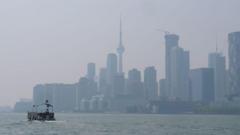A deadly junction for migrating birds in Chicago, the McCormick Place conference center has taken measures to prevent bird strikes, significantly improving the safety of these travelers during peak migration periods.
Chicago's Solution to Protect Migratory Birds from Lethal Glass Structures

Chicago's Solution to Protect Migratory Birds from Lethal Glass Structures
New strategies implemented at the McCormick Place conference center aim to reduce bird fatalities during migration.
In the bustling city of Chicago, one location has been a notorious hotspot for bird fatalities during seasonal migrations— the McCormick Place conference center. This glass-laden structure, situated along the scenic shore of Lake Michigan, has long posed a threat to migrating birds as they navigate the urban landscape. Confused by reflections and bright lights, many of these delicate travelers have met their fate against the building's transparent exterior.
As spring migration unfolded in late April, a call to action was issued to volunteers, urging them to prepare for a morning dedicated to rescuing injured birds and documenting those that had not survived. Traditionally, this day has highlighted the devastating reality of urban bird strikes, especially given that the McCormick Place conference center accounted for nearly a thousand bird fatalities in one October day last year.
However, change is afoot. Recognizing the urgency of the situation, new protective measures have been implemented at the venue, offering hope for the safety of these migratory birds. By treating the windows with specialized patterns designed to deter strikes, the center embodies the combination of local initiative and environmental awareness—an essential step in addressing the broader issue within urban landscapes.
This innovative approach represents a fraction of the ongoing "50 States, 50 Fixes" initiative, a series focused on uncovering local solutions to pressing environmental challenges. As more cities look to adopt similar strategies, the outcome of efforts at McCormick Place could influence broader wildlife conservation methodologies in urban environments across the country.





















